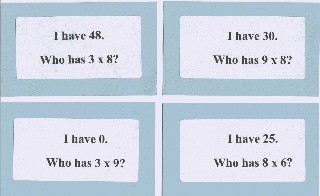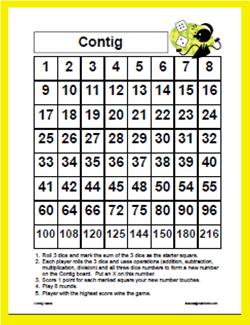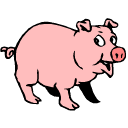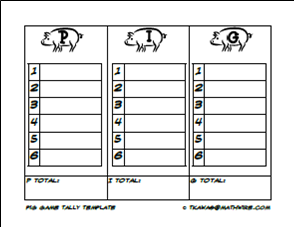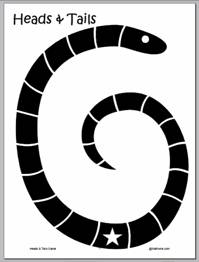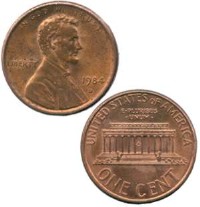- Mad Minute: insert a facts worksheet into a page protector. The student uses a dry-erase marker to complete as many facts as possible in one minute. Many students respond positively to this experience as it's only a minute. They can practice graphing skills by graphing the number of correct facts for each day.
- Who Has? Card Decks: read about and download Who Has? cards from Mathwire's collection, print out the labels and apply to index cards to easily create a deck. Shuffle the deck and deal out the cards. Each player turns over his/her cards. The person who has the I have 0. card begins. After reading a card, the player turns over that card, and play continues. The first player to read all of his/her cards wins. NOTE: This is a totally random winning, but students seem to be challenged by the prospect of "winning."
- Contig: Play this game to help older students develop fact fluency with addition, subtraction, multiplication and division facts. The beauty of the Contig game is that students will practice facts for several options, searching for the move that yields the most points. Download the Contig game mat and directions from Mathwire.

Friday, July 30, 2010
Summer Basic Facts Practice
Students may easily lose fact mastery over the summer without some kind of regular practice. Parents may help students retain mastery by utilizing small moments of time on a daily basis. Here are some suggestions:
Labels:
basic facts,
Contig,
facts mastery,
game,
Mad Minute,
mastery,
Who Has
Thursday, July 15, 2010
The Game of Pig
Pig is one of my favorite probability games. I have played the game with kindergarten through college level students and used it in teacher training sessions. Everyone LOVES the game and it's fun to watch who plays it safe and who's the risk-taker.
In my own classroom experience, I have found that this is best introduced as a class activity. Students collect points for each toss of the die unless a ONE is tossed, which means they lose all of the points they have collected in the round. To prevent losing their points, students may elect to stop at any point in the game before a ONE is tossed and they get to keep the points they collected but get no further points. Students love the game and begin to appreciate that theoretical probability and experimental probability are often quite different!
I devised a method that uses only one die tossed by the teacher, so this is a great transition activity that quiets a class as they strain to hear and record the results of the die toss AND decide if they will stop or continue to play. It's a win-win because students feel that they're playing, but they're actually learning a lot about the probability of a one-die toss.
Extending the Data Collection & Analysis:
In my own classroom experience, I have found that this is best introduced as a class activity. Students collect points for each toss of the die unless a ONE is tossed, which means they lose all of the points they have collected in the round. To prevent losing their points, students may elect to stop at any point in the game before a ONE is tossed and they get to keep the points they collected but get no further points. Students love the game and begin to appreciate that theoretical probability and experimental probability are often quite different!
I devised a method that uses only one die tossed by the teacher, so this is a great transition activity that quiets a class as they strain to hear and record the results of the die toss AND decide if they will stop or continue to play. It's a win-win because students feel that they're playing, but they're actually learning a lot about the probability of a one-die toss.
Download Pig directions.- Download Pig template or Pig Tally template, and place in a sheet protector to record die tosses. Students may use dry erase markers for a reusable recording sheet. The Pig Tally template requires students to use tally marks to record each toss of the die. This recording sheet is a very visual presentation of the results and proves extremely useful when students devise winning strategies, as described below.
Extending the Data Collection & Analysis:
- Ask pairs or small groups of students to talk about the game and come up with a winning strategy. For example, some groups decide to stop once they have 20 points. Another group decides to stop when they get 3 of any number.
- Have each group share their winning strategy and explain why they think it is a winner.
- Play the game again. Groups MUST play according to their winning strategy.
- Discuss the results and allow groups to refine their strategies, if desired, before playing 1-2 more times.
- Finally, ask students to write about what they learned from this game. Is there really a winning strategy that works all the time? Explain your thinking.
Friday, July 9, 2010
Heads and Tails Investigation
Explore the probability of a one-coin toss using the Heads and Tails Game. This is an easy game for young learners. All you need to play is the Heads and Tails gameboard, two coins for markers and another coin to flip. Use a coin toss to decide who will be heads and who will be tails. Then the fun begins!
PLAYING THE GAME:
Both players place their marker coins on the star on the snake. The player who is HEADS flips the coin first. If the flip is HEADS, the player moves his/her marker one space toward the head. If the flip is TAILS, the player doesn't move.
Next, the TAILS player, flips the coin, moves one space if it lands on TAILS, stays put if it comes up HEADS.
Play continues switching back and forth until one of the players' markers reaches the head of tail of the snake to win the game.
DISCUSSION:
Do both players have an equal chance of winning? Try keeping a record of several games to see if HEADS and TAILS really both win.
Does it matter who goes first? Sometimes let HEADS go first; other times, let TAILS go first.
Use a simple tally sheet to record whether HEADS or TAILS wins each game.
VARIATION:
EXTENDED PLAY OPTION: The HEADS player tosses the coin. If it comes up HEADS, the player moves the coin one space toward the head and tosses again. If it comes up TAILS, the player stops and does not move. The TAILS player now tosses the coin. If the toss comes up TAILS, the player moves the coin one space toward the tail and tosses again. The player continues as long as the toss comes up TAILS. The game continues until a player's marker reaches the HEAD or TAIL of the snake.
DISCUSSION:
Do both players still have an equal chance of winning?
Does the game go faster this way? Explain.
What was the longest move either HEADS or TAILS got on one turn?
MODIFICATIONS:
If young players have trouble tossing the coin, use a small container and let them drop the coin into the container.
OR place the coin in a small see-through container such as a clear plastic jar with lid. Players then simply shake the jar and place it down on the table on its lid. It's easy to see whether it landed on HEADS or TAILS without opening the jar.
Buy larger coins at the dollar store. Remember that these are not the same weight as real coins and any imperfections may affect the outcome of the games. This could prove an interesting investigation for older players. Are some coins HEADS-winning coins and others TAILS-winning coins or are they all fairly equal?
Labels:
coin,
discrete math,
game,
heads,
probability,
tails,
toss
Subscribe to:
Posts (Atom)
